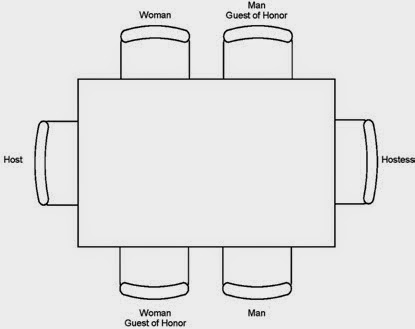Traditionally at a formal dinner, the Host sits at the head of the table with the Hostess at the other end. This works whenever there are six, ten, fourteen, or eighteen people. Husbands and wives are never seated next to each other.
If the Guest of Honor is a woman, she is seated at the Host's right and her husband at the Hostess' right. The second most important woman is seated across from the Guest of Honor, on the Host's left, and her husband is seated accordingly on the Hostess' left. The remaining guests are seated in between, alternating between male and female guests.
To be fair, the word "important" can be relative to many differing situations and varying cultures. Age may play a factor, especially if there is no Guest of Honor. Giving the eldest member of a group, or the persons who have traveled the farthest distance to the dinner, special places in the seating arrangement, would be an honor. Special accommodations may be also be made for those in wheelchairs, or those using a walker or cane. Guests take note of such matters and will undoubtedly appreciate the kind gestures on a Hosts and Hostess' parts.
 |
| Formal Table Seating For Groups Divisible By Four |
When the group of people is divisible by four, it is not possible for the Hostess to sit at the end of the table. In this case, the Hostess moves one place to the left, with the man on her right sitting at the end of the table, opposite the Host. This will keep the tradition of seating guests alternately, male, female, male, female, etc... Again, husbands and wives are never seated next to each other.
For informal dining, the easiest system is to alternate between male and female guests, with the Host and Hostess on either end of the table.
Contributor Bernadette Petrotta is the Founder and Director of the Polite Society School of Etiquette in Washington State. She has been teaching etiquette for nearly 20 years and has written The Art of Social Graces and The Art and Proper Etiquette of Afternoon Tea. She is currently working on her third book and continues to teach and lecture on the art and pleasures of proper etiquette and tea.
🍽Etiquette Enthusiast, Maura J. Graber of The RSVP Institute of Etiquette, is the Site Editor for the Etiquipedia© Etiquette Encyclopedia


How do you take a seat the dining table i.e from the left of the chair or right of the chair or either way is correct? Then how do you leave the chair ie from left or right or either way is fine?
ReplyDeleteHow do you take a seat the dining table i.e from the left of the chair or right of the chair or either way is correct? Then how do you leave the chair ie from left or right or either way is fine?
ReplyDeleteIt is dependent on several factors, so common sense and some quick thought comes into play, just as it does with most other etiquette. Is it a formal dinner party in someone’s home? How many others are seating themselves at the same time? How is the table set up? Will seating yourself from the left side of the chair interfere with someone serving food? In the U.S., food and drinks are served on different sides — food from the left, drinks from the right. In Europe, everything is served from the right — food and drinks. Silently, ask the same question to yourself as you are walking toward the table on the right side. If one is in a restaurant, is everyone being seated at the same time? Are you joining a party already seated. Does someone have a walker, cane or other aid, sitting next to their chair that will impede your seating yourself? As a rule, I personally tend to “enter“ the seat from the left and “exit” from the seat on my right. However, I always take a look around me before making those choices, and ask myself it it will work effortlessly, or if I will be causing discomfort or a challenge for anyone near me. Either way is fine, as long as no one else will be put out by your choice.
DeleteThis comment has been removed by a blog administrator.
ReplyDeleteIs there any precedent for how to arrange seating plans including persons who are nonbinary or trans?
ReplyDeleteNo precedent that I am aware of has been set. Seating arrangements are entirely up to the host and/or hostess or governing body, as is the case of diplomatic or royal protocol. A host or hostess can stick with tradition or not. No, such tradition has been started regarding the non-binary or trans community, as it is such a small segment of the overall population. If a much, much larger segment of society were to evolve, similar to the 2 largest now — the male and the female segments — I am certain a precedent would be set and recorded somewhere. As it is hard to get people to practice, even the most basic of etiquette rules routinely, I doubt this will happen anytime soon. I will, however, keep this site up-to-date, and will certainly reference such a precedent if one is ever set.
DeletePlease dismiss the unintentional and errant comma in the line, “No such tradition has been started.”
Delete